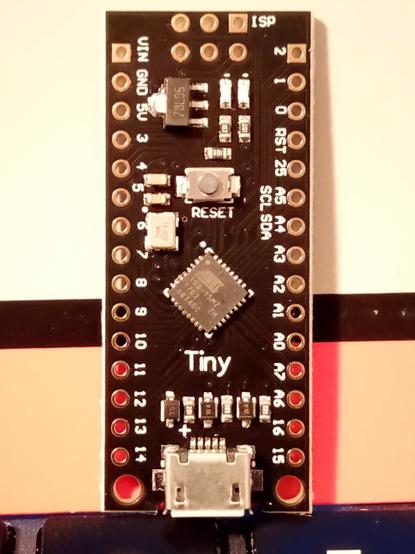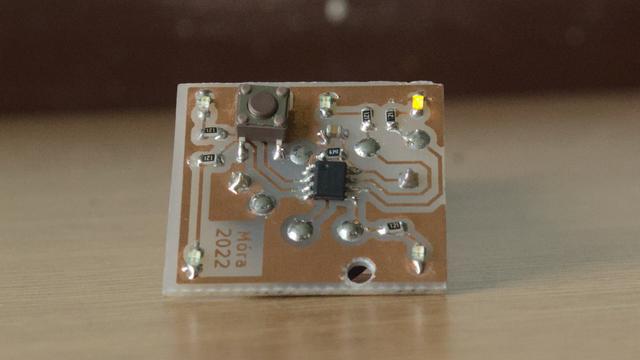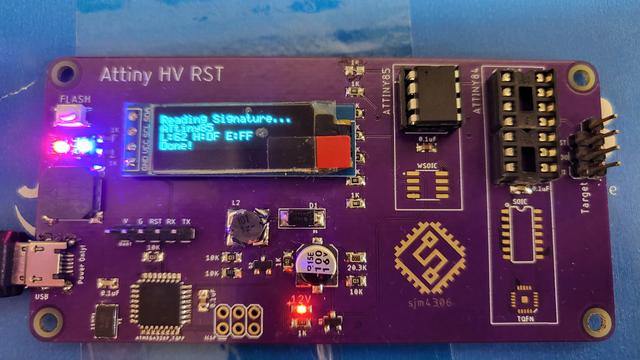2024 Tiny Games Contest: Spectacular Sub-Surface Simon https://hackaday.com/2024/09/12/2024-tiny-games-contest-spectacular-sub-surface-simon/ #2024TinyGamesChallenge #ATtinyHacks #contests #attiny84 #Games
#ATtinyHacks
2024 Tiny Games Contest: An Epic Minimalist Entertainment System, Indeed https://hackaday.com/2024/09/08/2024-tiny-games-contest-an-epic-minimalist-entertainment-system-indeed/ #2024TinyGamesChallenge #ATtinyHacks #contests #attiny10 #GPD340 #Games
Nice Retro Displays Set This Watch on Edge https://hackaday.com/2024/08/27/nice-retro-displays-set-this-watch-on-edge/ #WearableHacks #ATtinyHacks #ledmatrix #attiny85 #watch
Two-Channel Guitar Stomp Box Makes Momentary Switches Latching https://hackaday.com/2023/11/19/two-channel-guitar-stomp-box-makes-momentary-switches-latching/ #shouldhaveuseda555 #microcontroller #MusicalHacks #ATtinyHacks #effectpedal #attiny2313 #momentary #latching #stompbox #guitar #relay
Chip Shortage Engineering: Misusing DIP Packages https://hackaday.com/2023/10/03/chip-shortage-engineering-misusing-dip-packages/ #footprintcreation #ATtinyHacks #OriginalArt #Featured #Interest #PCBHacks #attiny85 #dipchip #Skills #Parts #KiCAD #soic8 #soic #dip #sao
ACK1 Makes Getting to Know the ATtiny1616 Easy https://hackaday.com/2023/08/30/ack1-makes-getting-to-know-the-attiny1616-easy/ #diyelectronics #ATtinyHacks #attiny1616 #attiny
This is supposed to be an AT Tiny 88 and a clone of the Arduino Nano. It doesn't seem to like the Arduino IDE so I'm stumped right now. I think it might need its own IDE.
Any ideas? I'm using Linux mint cinnamon.
Building an Energy Sword Replica From Halo https://hackaday.com/2023/04/01/building-an-energy-sword-replica-from-halo/ #gamingreplica #ATtinyHacks #energysword #plasmasword #replica #gaming #Games #halo2 #halo
Help! I can't stop buying random microcontrollers and tinker stuff and then not do anything with it because I'm not creative enough or don't actually have the time for it. What do I do?
#esp32 #attinyhacks #arduino
Electronics And C++ Education With an ATTiny13
When [Adam, HA8KDA] is not busy with his PhD studies, he mentors a group of students interested in engineering. To teach them a wide range of topics, he set out to build a small and entertaining embedded project as they watch and participate along the way. With this LED-adorned ATTiny13A project, [Adam] demonstrated schematic and PCB design, then taught C++ basics and intricacies - especially when it comes to building low-footprint software - and tied it all together into a real-world device students could take home after the project. His course went way beyond the "Hello world"s we typically expect, and some of us can only wish for a university experience like this.
He shares the PCB files and software with us, but also talks about the C++20 framework he's developed for this ATTiny. The ATTiny13A is very cheap, and also very limited - you get 1K of ROM and 64 bytes of RAM. This framework lets you make good use of it, providing the basics like GPIO wiggling, but also things like low-power operation hooks, soft PWM with optional multi-phase operation support and EEPROM access. Students could write their own animations for this device, and he includes them in the repo, too!
In educational projects, it pays to keep code direct and clean, cruft-less and accessible to students. These are the things you can only achieve when you truly understand the tools you're working with, which is the perfect position for teaching about them! [Adam] intends to show that C++ is more than suitable for low-resource devices, and tells us about the EEPROM class code he wrote - compiling into the same amount of instructions as an Assembly implementation and consuming the same amount of RAM, while providing compile-time checks and fail-safe syntax.
We've talked about using C++ on microcontrollers before, getting extra compile-time features without overhead, and this project illustrates the concept well. [Adam] asks us all, and especially our fellow C++ wizards, for our opinions on the framework he designed. Could you achieve even more with this simple hardware - make the code more robust, clean, have it do more within the limited resources?
What could you build with an ATTiny13, especially with such a framework? A flashy hairclip wearable, perhaps, or a code-learning RF-remote-controlled outlet. We've also seen a tiny camera trigger for endurance races,, a handheld Flappy Bird -like console, and many more!
#attinyhacks #microcontrollers #softwarehacks #attiny13 #attiny13a #avrattiny13 #c #c20 #education #educational
A Neat Little Tool to Reset the Fuses on Your ATtiny
If you're an experienced hacker, you've probably run into a problem at some point and thought "let's make a tool to automate that". A few hours later you've got your tool, but then realize that the amount of work you put into making the tool vastly exceeds what you would have needed to solve the original problem manually. That really doesn't matter though: developing a fancy tool can be a rewarding experience that teaches you way more about the original problem than you would have learned otherwise. [sjm4306]'s ATtiny High Voltage Fuse Reset-er is a clever device that firmly falls into this category.
The problem it solves is familiar to anyone who's ever worked with Atmel/Microchip's ATtiny series of microcontrollers: set one of the configuration fuses incorrectly and you're no longer able to reprogram your chip. Getting the ATtiny back to its original configuration requires a high-voltage programming step that involves pulling the reset pin to 12 V in what's otherwise a 5 V system. You could simply grab a spare 12 V supply and hack together a level shifter with a few transistors, but where's the fun in that?
[sjm4306]'s solution is built on a pretty purple PCB that contains an ATmega328, an OLED display, and sockets to accommodate various versions of the ATtiny series microcontrollers. To generate the required 12 V, one could simply use an off-the-shelf boost converter IC. But instead, he decided it would be interesting to make such a circuit out of discrete components and control it using the ATmega. After all, this chip already contains timers to generate PWM signals and an ADC to measure the converter's output voltage, so all it took was to write some control logic in the form of a PID controller.
The end result, as you can see in the video embedded below, is a convenient little PCB that runs off a 5 V USB power supply and resets the fuses on your ATtiny at the push of a button. Sometimes, simple tools that do one thing well are all you need; however, if you're looking for an all-in-one AVR programmer that also supports HV programming, check out this AVR Multi-Tool.
#attinyhacks #toolhacks #attiny #boostconverter #hvprogramming
Mindblowing Graphics from an ATtiny85
[Görg Pflug] wrote in with his really nice graphics library. It's got multiple layers, two text consoles, greyscale, internal halftoning, and sprites. It can pull off a number of classic graphics tricks and demos. Oh yeah, and did we mention it runs on a freaking ATtiny85 and an I2C OLED screen?!
This is an amazing piece of work -- if you'd asked us if this was possible, we would have probably said "no". And now it's yours to use in your own projects. The GitHub repo is full of demos showing off everything from switching between multiple layers, extremely rapid text scrolls, animations, boing balls, and even a Wolfenstein-style raycaster. On an ATtiny85.
There's a demo video, embedded below, that shows it all off, but honestly you have to think about what's going to to be suitably wowed. The first demo just seems to have a graphic wave over static text, for instance. No big deal? It's blending the greyscale layers together and dithering them out to black and white for the OLED in real time! On an ATtiny85.
While the library is written in straight C++, there are even a couple examples of how you'd integrate this with Arduino's Wire library if you so wished. We don't know about you, but this makes us want to whip together an ATtiny85 and SSD1306 OLED demo board just to start playing around. This isn't just an amazing hack, but it would also be a useful way to add graphics and a nice console to any project you're working on.
Did we mention it's all done on an ATtiny85? Over I2C? Kudos!
#attinyhacks #microcontrollers #softwarehacks #attiny85 #graphics #library #oledscreen #sprites
ATtiny85 Snake Game is a Circuit Sandwich
If there's any looming, unwritten rule of learning a programming language, it states that one must break in the syntax by printing Hello, World! in some form or another. If any such rule exists for game programming on a new microcontroller, then it is certainly that thou shalt implement Snake.
This is [cultsauce]'s first foray away from Arduinoville, and although they did use one to program the ATtiny85, they learned a lot along the way.
It doesn't take much to conjure Snake with an '85 -- mostly you need a screen to play it on (an OLED in this case), some buttons to direct the snake toward the food dot, a handful of passives, and a power source.
[cultsauce] started by programming the microcontroller and then tested everything on a breadboard, both of which are admirable actions. Then it was time to make this plywood and cork sandwich, which gives the point-to-point solder joints some breathing room and keeps them from getting crushed. Be sure to check it out in action after the break, and grab the files from GitHub if you want to charm your own 'tiny Snake.
There's a ton you can do with this miniature microcontroller, and that includes machine learning.
HVTPI Primer And Toolkit Equips You For BOM Substitutions
Novel programming interfaces for MCUs might catch us by surprise, but then we inevitably get up to speed with the changes required. Today's bastion is HVTPI - a "12V reset" addition to the TPI we've just started getting used to, and [Sam Ettinger] has shared a simple circuit to teach us all about it, along with PCB files and detailed explanations of how it all works.
HVTPI is an add-on on top of TPI, for which, as Sam explains, you need to hold RST at 12V when TPI would have it be low logic level, and leave it at Vtarget otherwise. For that, he has designed a variety of interposer boards of various complexity and requirements; explaining the choices behind each one and clearing up any misunderstandings that might occur on your way. All of the board files (and the TPI write-up copy) are caringly shared with us in a git repository, too! As a result, if you have an USB-ASP or an Arduino available, now you also have everything to do HVTPI, thanks to Sam's work and explanations.
We've been covering Sam's exploits before, and can't help but be grateful for the stop-and-explain detour along the way. HVTPI being used on very small ATTiny parts, we wonder if something new in the vein of his recent FPC board able to fit and function entirely within a Type-C cable end!
With chip shortages, investigating programming interfaces for small and obscure yet in-stock microcontrollers has been, quite literally, paying off, and if you got some projects that need a MCU but won't consume a whole lot of resources, it could be time to give an ATTiny10 a go. What's the worst that can happen - you make the smallest chiptunes ever?
#attinyhacks #microcontrollers #toolhacks #atmeltpi #attiny #attiny10 #attiny4 #attiny5 #attiny9 #hvtpi #insystemprogramming #isp #tpi #usbasp
You Can Always Use An ATtiny Instead Of A 555
It's a constant of writing for Hackaday, that whenever a project appears using a 555 timer, someone will say "You could have used a microcontroller to do that!". It's something that [Shranav Palakurthi] has approached with the ATTiny555, a project that emulates an entire 555 by making clever use of the humble and ubiquitous microcontroller chip. We've all been guilty of it at some time, but now at last the ATTiny85 enthusiasts have conclusive proof that their favourite piece of cheap silicon can prove its mettle.
The full details of the ingenious 555 replacement can be found in its GitHub repository, and for those willing to take the plunge it's as simple as adding a resistor and updating the firmware. It's not the perfect 555 replacement with its imperfect analogue performance and swapped reset and ground pins, but it does however bring the advantage of a lower supply voltage.
You can see the device in action in the YouTube video below the break, but meanwhile rejoice that finally there's a way to replace all those unnecessary 555s with your favourite inexpensive 8-pin chip!
While we're on the subject of the 555, don't forget we're running our 555 contest again.
Don’t Walk Past This 3D Printed Pedestrian Crossing Light
There's just something so pleasing about scaled-down electronic replicas, and this adorable 3D printed pedestrian crossing light by [sjm4306] is no exception.
Although a little smaller than its real-world counterpart, the bright yellow housing and illuminated indicators on this pedestrian lamp are instantly recognizable due to their ubiquitous use throughout the United States. The handful of printed parts are held together using friction alone, which makes assembly a literal snap. The 'safety grill' with its many angles ended up being one of the most tedious parts of the build process, but the effort was definitely justified, as it just wouldn't look right without it.
A suitably minuscule ATtiny85 drives a pair of LED strips that effectively mimic the familiar symbols for 'Walk' and 'Don't Walk'. [sjm4306] has designed the board and case in such a way to accommodate a variety of options. For example, there's just enough room to squeeze in a thin battery, should you want to power this contraption on-the-go. If you don't have an ATtiny85 on hand, the board also supports an ATmega328p or even an ESP8266.
All the build details are available over on Hackaday.io. While it's billed as a 'night light', we think this could be an awesome platform for an office toy, similar to this office status light project. Or if you've somehow already got your hands on a full-size pedestrian lamp, why not hook it up to the Internet?
#3dprinterhacks #attinyhacks #3dprinting #arduino #portabletrafficlights #trafficlights
Scrolling Name Badge Is Sure to Break the Ice
Most makerspaces and hackerspaces have one night per week or month where the 'space is open to the public in order to entice new people into joining up. Whereas most members just write their name in Sharpie on a piece of masking tape, [Madison] wanted to do something extra. And what better way to get people interested in your 'space than by wearing something useful that came out of it?
The badge runs on an ATtiny45 and uses three 8×8 ultra-bright LED matrices for scrolling [Madison]'s name. It's powered by a tiny LiPo battery that is boosted to 5 V. This build really shows off a number of skills, especially design. We love the look of this badge, from the pink silkscreen to the the typography. One of the hardest things about design is finding fonts that work well together, and we think [Madison] chose wisely. Be sure to check it out in action after the break.
Custom name badges are a great way to start conversations no matter where you go. Here's one that uses EL wire and LEDs that light up in sequence for an animated effect.
Thanks for the tip, [Michael Gardi]!
#attinyhacks #ledhacks #attiny45 #boostconverter #ledmatrix #namebadge
Tiny Talisman Warns Wearer About UV Exposure
Given how important our Sun is, our ancestors can be forgiven for seeing it as a god. And even now that we know what it actually is and how it works, it's not much of a reach to think that the Sun pours forth evil spirits that can visit disease and death on those who bask too long in its rays. So an amulet of protection against the evil UV rays is a totally reasonable project, right?
As is often the case with [mitxela]'s projects, especially the more bedazzled ones, this one is approximately equal parts electronics and fine metalworking. The bulk of the video below focuses on the metalwork, which is pretty fascinating stuff. The case for the amulet was made from brass and sized to fit a CR2032 coin cell. The back of the amulet is threaded to act as a battery cover, and some fancy lathe work was needed there. The case was also electroplated in gold to prevent tarnishing, and lends a nice look when paired up with the black solder mask of the PCB.
On the electronics side, [mitxela] took pains to keep battery drain as low as possible and to make the best use of the available space, choosing an ATtiny84 to support a TTP223 capacitive sensing chip and a VEML6075 UV sensor. The touch sensor allows the wearer to wake the amulet and cycles through UV modes, which [mitxela] learned were not exactly what the sensor datasheet said they were. This required a few software hacks, but in the end, the amulet does a decent job of reporting the UV index and looks fantastic while doing it.
#art #attinyhacks #wearablehacks #attiny84 #coincell #jewelry #metalworking #ttp223 #uv #uvindex #uva #uvc #veml6075
‘Tiny Wake-Up Light Is Hugely Bright
Let's face it -- waking up is rough no matter what time of year it is. But the darkness of fall and winter makes it so much worse. In the past, [Maarten] has used music with increasing volume, but depending on the setup, it can be dodgy if you want to hear a different song each day and don't have all your files volume-leveled.
Wake Up Bright is the latest in a line of wake-up widgets [Maarten] has made to help rouse them in the morning. Their write-up covers all ideas they've had on the subject over the years, as well as the electronics, firmware, debugging, and all the upgrades made after using it for awhile.
Slowly brightening an LED doesn't have to be difficult or expensive. [Maarten] originally used an Atmel 90S2313 AVR and later upgraded to an ATtiny 2313, which was easy because the two are pin-compatible. The 2313 outputs PWM, which duty-cycles the LED to create a nice fade-in of white light that is way more gentle than that classic 1980s alarm clock buzz-beep.
Over time, this project went from one IKEA enclosure to another. We really like the newer one, which looks like it was designed for people to hack into a wake-up light.
Our eyes perceive brightness increases logarithmically, but PWM is linear. We can get around this by multiplying the PWM value by some factor every so often, but the problem is that this AVR never learned its multiplication tables. So how, then? [Maarten]'s answer is byte shifting using a 16-bit register -- one byte for PWM, and the other as a scratch pad to do logarithmic math. [Maarten] multiplies the 16-bit register by 1/256 every couple of seconds, which results in a logarithmic increase of brightness. It's calculated for a 15-minute sunrise, which required some experimentation to get right.
Whereas [Maarten] started with a 3 W RGB LED, the current version has three 10 W LEDs and uses a power supply from an old monitor. Daylight Saving Time is coming to an end in the US, and it's gonna get worse quickly. Lucky for you, this project is completely open source down to the firmware.
You think that 1980s alarm clock buzz-beep is bad? How about some repeated slaps to the face to wake up?
#attinyhacks #lifehacks #7805 #artificialsunlight #attiny2313 #sunriselight










